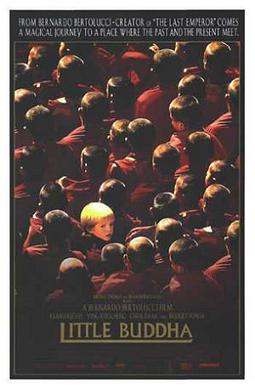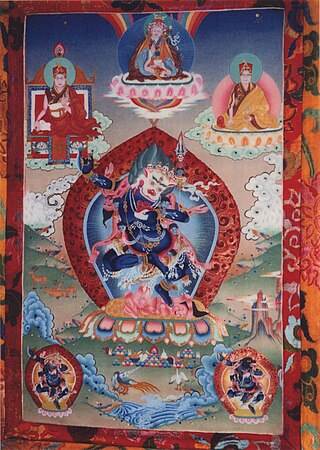A tulku is a distinctive and significant aspect of Tibetan Buddhism, embodying the concept of enlightened beings taking corporeal forms to continue the lineage of specific teachings. The term "tulku" has its origins in the Tibetan word "sprul sku", which originally referred to an emperor or ruler taking human form on Earth, signifying a divine incarnation. Over time, this term evolved within Tibetan Buddhism to denote the corporeal existence of highly accomplished Buddhist masters whose purpose is to ensure the preservation and transmission of a particular lineage.

Tashi Paljor, Dilgo Khyentse Rinpoche was a Vajrayana master, scholar, poet, teacher, and recognized by Buddhists as one of the greatest realized masters. Head of the Nyingma school of Tibetan Buddhism from 1988 to 1991, he is also considered an eminent proponent of the Rime tradition.

The Rimé movement is a movement or tendency in Tibetan Buddhism which promotes non-sectarianism and universalism. Teachers from all branches of Tibetan Buddhism – Sakya, Kagyu, Nyingma, Jonang, Gelug, and Bon – have been involved in the promoting Rimé ideals.

Nyingma, often referred to as Ngangyur, is the oldest of the four major schools of Tibetan Buddhism. The Nyingma school is founded on the first lineages and translations of Buddhist scriptures from Sanskrit into Tibetan in the eighth century, during the reign of King Trisong Detsen.

Little Buddha is a 1993 drama film directed by Bernardo Bertolucci, written by Rudy Wurlitzer and Mark Peploe, and produced by usual Bertolucci collaborator Jeremy Thomas. An international co-production of Italy, France and the United Kingdom, the film stars Chris Isaak, Bridget Fonda and Keanu Reeves as Prince Siddhartha.

Jamyang Khyentse Wangpo, also known by his tertön title, Pema Ösel Dongak Lingpa, was a teacher, scholar and tertön of 19th-century Tibet. He was a leading figure in the Rimé movement.
In Tibetan Buddhism, Ngöndro refers to the preliminary, preparatory or foundational practices or disciplines common to all four schools of Tibetan Buddhism and also to Bon. They precede deity yoga.

Dzongsar Khyentse Chökyi Lodrö was a Tibetan lama, a master of many lineages, and a teacher of many of the major figures in 20th-century Tibetan Buddhism. Though he died in 1959 in Sikkim, and is not so well known in the West; he was a major proponent of the Rimé movement within Tibetan Buddhism, and had a profound influence on many of the Tibetan lamas teaching today.

Sogyal Rinpoche was a Tibetan Dzogchen lama. He was recognized as the incarnation of a Tibetan master and visionary saint of the 19th century, Tertön Sogyal Lerab Lingpa. Sogyal Rinpoche was the founder and former spiritual director of Rigpa — an international network of over 100 Buddhist centres and groups in 23 countries around the world — and the author of the best-selling book The Tibetan Book of Living and Dying, which has been printed in 30 languages and 56 countries. Before his retirement, in the wake of abuse allegations in 2017, he had been teaching for 40 years in Europe, America, Asia and Australia.

Kyabje Dudjom Rinpoche Jigdral Yeshe Dorje was known simply as Dudjom Rinpoche. He is considered by many Tibetan Buddhists to be from an important Tulku lineage of Terton Dudul Dorje (1615-1672), and was recognized as the incarnation of Terton Dudjom Lingpa (1835-1904), a renowned treasure revealer. He was a direct incarnation of both Padmasambhava and Dudjom Lingpa. He was a Nyingma Householder, a yogi, and a Vajrayana and Dzogchen master. According to his secretary Khenpo Tsewang Dongyal and many others, he was revered as "His Holiness" (Kyabje) and as a "Master of Masters".

Ayu Khandro, also known as Dorje Paldrön, was a Tibetan yogini, practitioner and terton of Tantric Buddhism in Eastern Tibet. An accomplished Dzogchen meditator, she is known for her extensive pilgrimages throughout Tibet, long periods of dark retreat practice, the gongter of the practice of the yidam Senge Dongma, various forms of Chöd, and her lifelong dedication to spiritual practice.

Kyabje Dungse Thinley Norbu Rinpoche was a major modern teacher in the Nyingma lineage of Tibetan Buddhism, and patron of the Vajrayana Foundation. He was the eldest son of Dudjom Rinpoche, the former head of the Nyingma lineages, and also the father of Dzongsar Jamyang Khyentse Rinpoche and Dungse Garab Rinpoche. His association with the Dudjom Lineage is a long one: he is held to be the incarnation of Tulku Drime Oser, who was one of seven sons of Dudjom Lingpa. He also was considered to be an emanation of Longchen Rabjam, the great 14th-century Nyingma scholar and siddha who composed the Seven Treasuries. He died in California on December 26, 2011, according to the Tibetan Buddhist Lunar Calendar the 2nd day of the 11th month of the Iron Rabbit year. His cremation was held in a public buddhist cremation ceremony in Paro, Bhutan on March 3, 2012, which was attended by several thousand people, including some of Bhutan's royal family.

Khenpo Shenga Rinpoche, also Shenpen Chökyi Nangwa (1871–1927) was a Tibetan scholar in the Nyingma and Sakya traditions of Tibetan Buddhism.

Jigdal Dagchen Sakya Rinpoche was a Tibetan Buddhist teacher educated in the Sakya sect. He was educated to be the head of the Sakya school of Tibetan Buddhism as well as the successor to the throne of Sakya, the third most important political position in Tibet in early times. Dagchen Rinpoche was in the twenty-sixth generation of the Sakya-Khön lineage descended from Khön Könchok Gyalpo and was regarded as an embodiment of Manjushri as well as the rebirth of a Sakya Lama from the Ngor sub-school, Ewam Luding Khenchen Gyase Chökyi Nyima.
The Second Beru Khyentse, born Thupten Sherap is a lineage holder of the Karma Kagyu school of Tibetan Buddhism and the third reincarnation of Jamyang Khyentse Wangpo (1820–1892).
Orgyen Tobgyal Rinpoche, also called Tulku Ugyen Topgyal, is a Tibetan Buddhist lama who was born in Kham in Eastern Tibet in 1951, living in exile in India.

Dzongsar Monastery is a Buddhist monastery in Dêgê County in the Garzê Tibetan Autonomous Prefecture of Sichuan, China, southeast of the town of Derge and east of Palpung Monastery. Historically it lay in the Kham region of Tibet. It was founded in 746, destroyed in 1958, and rebuilt in 1983.

Nyoshül Khenpo Rinpoche, more fully Nyoshül Khenpo Jamyang Dorje, was a Tibetan lama born in the Derge region of Kham.

In Tibetan Buddhism, Siṃhamukhā or Siṃhavaktra, also known as the Lion Face Dakini or Lion-headed Dakini, is a wisdom dakini of the Dzogchen tradition. She is represented as a fierce dakini with the head of a snow lion. Her mouth is depicted with a roar, symbolizing untamed fury and jubilant laughter. Her roar disperses discursive thoughts. She is naked, symbolizing that she herself is completely free of discursive thought.
Jamyang is a given name. Notable people with the given name include:















